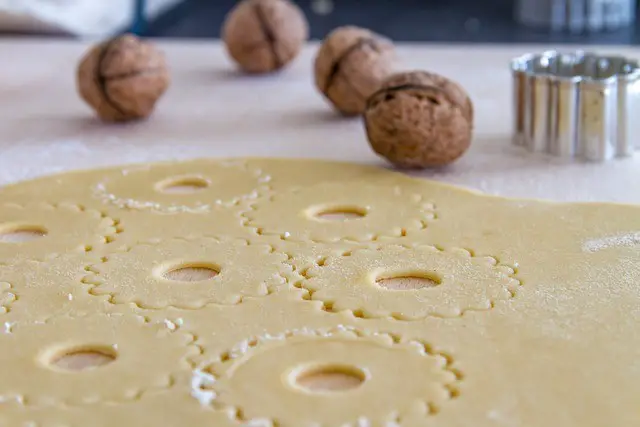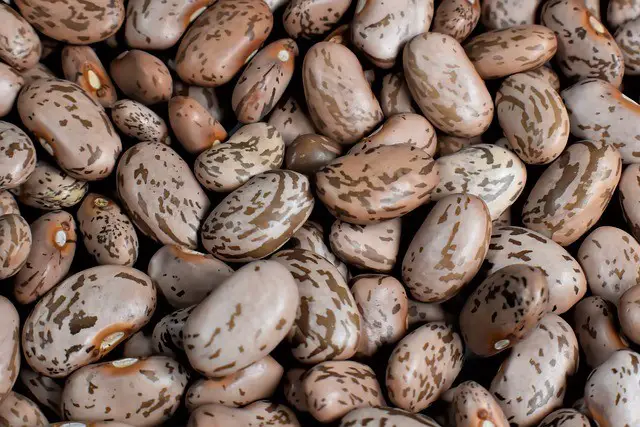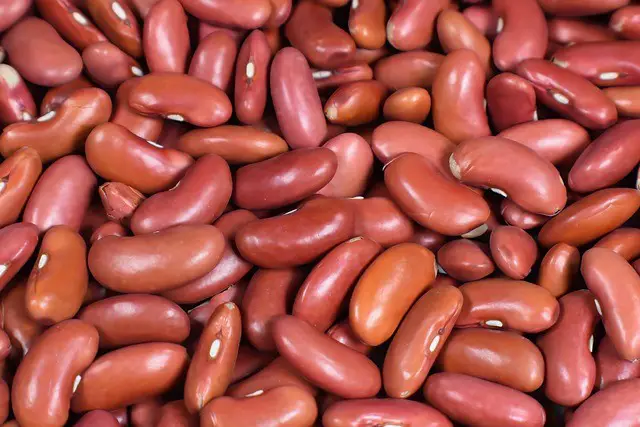Being a newbie in the streets of keto dieting can be very challenging, especially sniffing out the right products to use to stay within your recommended carb limit. The good news is thanks to the world of creativity you don’t have to ditch your favorite recipes due to high-carb ingredients.
Baking seems off the table when it comes to a ketogenic diet because its main ingredient is high carb. Whole grains, although healthy, have a high carb content and are prohibited on keto. However, there are low carb alternatives that can act as substitutes for the regular flour used when baking.
These substitutes are low in carbs and have a high fiber content and a higher fat content compared to the regular kind which makes them the perfect fit for keto. Nut flours are the best for low-carb baking. The nutty flavor adds the additional twist that will have your tastebuds tingling with joy.
What should you expect in this article? We will discuss the best low carb flour for baking and their carb count. In addition, we will compare their carb counts with that of regular wheat flour. I’ll also throw in some tips on storing your low carb substitutes so they can last for longer.
Low Carb Flour for Baking
Baking on a low-carb diet doesn’t have to be quite a headache. Knowing the right flour to use is the first step to doing things right. Traditional wheat flour is usually high in carbs, so it doesn’t cut it on keto.
Moreover, it is high in gluten which may affect individuals with celiac disease or non-celiac gluten sensitivity. This has also created the need for gluten-free alternatives for such individuals. How many carbs are in a cup of wheat flour?
According to the USDA, a 100 g serving size of wheat flour (unenriched) contains:
- Energy: 370 kcals
- Total Carbs: 71.2 grams of carbs
- Dietary fiber: 10.6 grams of fiber
- Net carbs: 60.6 grams of net carbs
- Protein: 15.1 grams of protein
- Fat: 2.73 grams of fat
Taking a look at the grams of carbohydrates in wheat flour, you can see that it will exceed your daily carb allowance on keto. The glycemic index of unenriched wheat flour (refined) is 85, and the glycemic load is 62.6. Can you imagine what this will do to your blood sugar levels? This flour is not good for diabetics.
Which alternative this will be good for keto dieters?
Low Carb Flour Alternatives
You may have heard so much noise on which is the best alternative to wheat flour but are still confused about what to go for. You need the right replacement in flavor, texture, and nutritional value for your regular kind.
Keep in mind that some of the alternatives listed below cannot be substituted directly in your wheat flour recipes. If the recipe requires say 2 cups of wheat flour, it doesn’t mean you will need the same amount of the low-carb substitute. I will mention how to use the alternatives to your high-carb flour in your recipes.
Best Low Carb Baking Flour
The best alternatives for low-carb baking recipes are high in fats and fiber and low carb. Finely ground nuts or seeds fit the bill perfectly!
Almond Flour
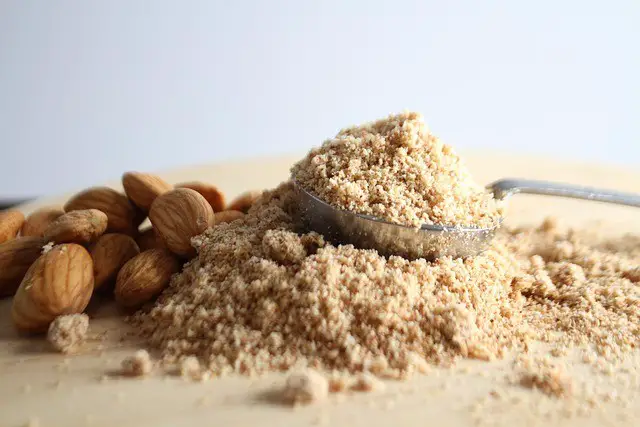
If you have been on the keto lifestyle for a minute, then you’re no stranger to almond meal or almond flour. The two can be used interchangeably, but the former has a finer texture while the latter is coarse. What about its carb count?
One cup of almond flour will provide you with:
- Energy: 648 kcals
- Total carbs: 24 grams of carbs
- Dietary fiber: 14 grams of fiber
- Net carbs: 10 grams of net carbs
- Protein: 24 grams of protein
- Fat: 56 grams of fat
When on the keto diet, this can be a good addition to your low carb foods. It is the easiest to use in a low carb recipe compared to other alternatives. You can avoid the gritty texture of your baked foods by adding the right liquid ingredients to almond flour. Use a 1:1 ratio with All-purpose flour.
Use a food processor or blender to make almond flour at home. Throw your whole almonds into your processor and blend. The power you use will determine the texture of your almond meal. You need to be careful how long you process your almonds or else you will end up with almond butter.
When it comes to storage, you need to act fast because this one spoils quickly in hot weather. After opening your package or making your it, pour it into an airtight container and refrigerate.
There are a few benefits of using almond flour over regular flour which include its moistness due to high fat content and it doesn’t rise as much as regular all-purpose flour. The disadvantages include:
- The cost: You will spend three to five times as much to buy this flour substitute.
- The nutty taste will transfer to your end products. This could be an issue if it wasn’t the flavor profile you were looking for.
- High in calories.
- Not good for people with nut allergies.
Incorporating almond flour into your diet will keep your carb intake low ensuring you stay in ketosis. The glycemic index of this flour is less than 1 and the glycemic load is 1.9. This means it’ll have little effect on your blood sugar and insulin levels.
Coconut Flour
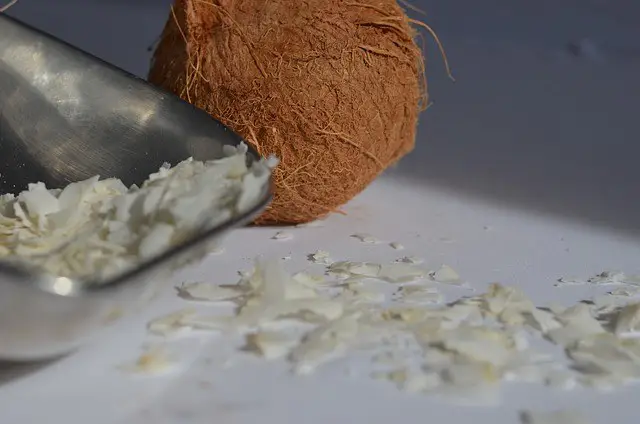
Still on the list of low carb flour for baking alternatives, coconut flour is another option you have. It is made from finely shredded and dried coconuts. It is popular thanks to its coconut flavors that unlock a whole new world of taste profiles.
How about the carbs in coconut flour? A cup of coconut flour contains:
- Energy: 441 kcals
- Total carbs: 83 grams carbs
- Dietary fiber: 48 grams fiber
- Net carbs: 35 grams net carbs
- Protein: 20 grams protein
- Fat: 14 grams fat
The main difference between coconut flour and almond flour is in the carb count. Coconut flour has a higher carb count compared to the other low carb alternatives. But thanks to its overpowering flavors, you only need a small amount of this flour, which also keeps your carb intake low. Baking with coconut flour allows for a combination of flours for the best taste profiles.
You would rather use this substitute in recipes with an airy texture like in muffins and cakes. When it comes to ratios, replace a cup of wheat flour with 1/4 cup of coconut flour in your baking. Add an extra egg to achieve similar texture and flavor profiles. Coconut flour contains absorbent fiber that sucks up moisture fast. This means you will need extra ingredients to keep your baked foods moist.
For this flour, store it in an airtight container in a cool dark space. Keep the environment dry to prevent your flour from absorbing moisture. The advantages of using this flour are it is easily available and may be used in some nut-free settings. The cons of coconut flour include:
- Its high absorbent fiber content makes it suck in too much moisture living your baked foods soggy.
- It is expensive to buy. The recipe also calls for extra ingredients for binding and moisture.
- Can cause abdominal distension in celiac disease patients.
- Is only 20-25% of the dry ingredients. It works best in a combination of flours.
The glycemic index of coconut flour is 49-51 while its glycemic load is 3. Diabetics can add it to their list of dry ingredients when baking because it won’t have a significant impact on their blood sugar levels.
Other nut flour you can use include walnut flour, macadamia nut flour, and Hazelnut flour. Walnut flour contains 1 gram of net carbs in 3 tbsp. servings. It is also best used as a combination of flours. You need a cup of walnut flour for every cup of all-purpose flour in your recipe.
One cup of hazelnut flour will provide you with only 9.2 grams of net carbs. Finally, you will get only 5.6 grams of carbs in a 100 g serving size of macadamia nut flour. The ratio of macadamia nut flour with wheat flour is 1:1. This flour will give your foods a chewy texture, mildly nutty taste, and some slight sweetness.
Low Carbohydrate Flour List
If you’re not a big fan of a strong flavor or nutty taste, worry not! There are alternative flours you can use that are not from nuts.
Low Carb Cake Flour Substitute
These options include:
Flaxseed Meal
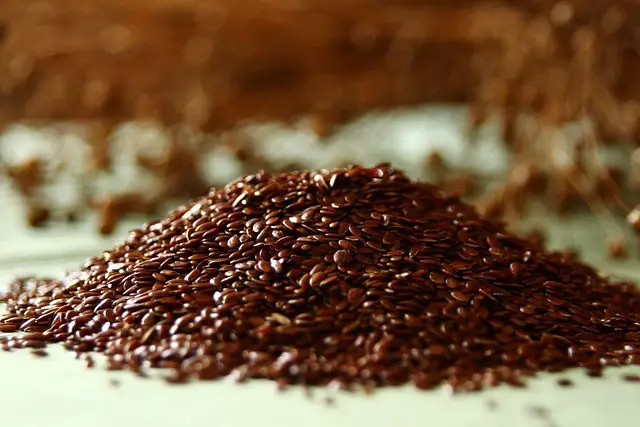
This is your number one alternative to nut flours. Flaxseeds are high in fiber and naturally low in carbs. This alternative flour is also referred to as Linseed flour. In 100 gram serving of Flaxseed meal you will get:
- Energy: 500 kcals
- Total carbs: 28.6 grams carbs
- Dietary fiber: 28.6 grams fiber
- Net carbs: 0 grams net carbs
- Protein: 21.4 grams protein
- Fat: 42.9 grams fat
Besides being low in carbs and high in fat, this flour is rich in the antioxidant lignan that helps with hormonal balance. Unlike coconut flour which is used in recipes with an airy texture, flaxseed flour is best for foods with dense textures.
The best part of using flaxseed flour is you don’t need eggs once you use it as a flour replacement! If you’re vegan or have an egg allergy, mix a tablespoon of ground flaxseeds with 3 tbsp. of water and give it time to swell. Although, this doesn’t work for egg-based meals, just those that call for eggs as extra ingredients.
Flaxseed flour has a glycemic load of 0 and the glycemic index is 35. People with uncontrollable blood sugar can use this low carb flour for baking.
Psyllium Husk Powder

This is probably the most difficult to use in your flour recipe. It comes in either white or brown. Psyllium husk powder like coconut flour is made up of 70% high moisture absorbent fiber.
In a 100 g serving size of this powder, you will get:
- Energy: 200 kcals
- Total carbs: 88.9 grams carbs
- Dietary fiber: 78 grams fiber
- Net carbs: 10.9 grams net carbs
- Protein: 0 grams protein
- Fat: 0 grams fat
This flour is used in small amounts in combination with other flour. It is preferred since it has a similar texture to gluten. It acts as a good blending agent in recipes thanks to its chewy texture and volume.
However, the downside of this powder is its too high in fiber and may cause indigestion and bloating.
Studies have shown that psyllium husk intake can improve insulin sensitivity and plasma glucose levels in individuals with type 2 diabetes.
Sunflower Seed Flour
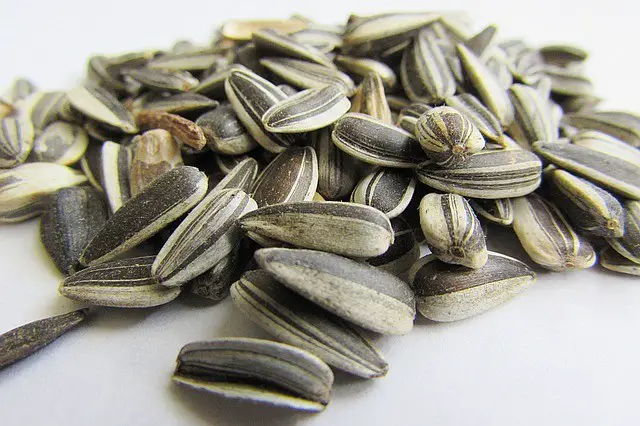
Made from grounding sunflower seeds to fine powder, this is one of the rarest keto flours on the market. If you have a tree nut allergy, this plant-based flour can be a good substitute for nut flour. One cup of sunflower seed flour (partially defatted) contains:
- Energy: 209 kcals
- Total carbs: 22.9 g of carbs
- Dietary fiber: 3.33 g of fiber
- Net carbs: 19.57 g of net carbs
- Protein: 30.8 g of protein
- Fat: 1.03 g of fat
This flour is easily made at home with a food processor. This is considering its rarity and how expensive it can be, it is wise to make your own. The flour is believed to have a similar glycemic index as sunflower seeds which is 35 and a glycemic load of 7.
You can store it in a cool dry place for up to 4 months without refrigeration.
Sesame Flour
You love your tahini (sesame paste), so you might enjoy sesame flour in your pastries. It is made from finely ground sesame seeds. In 100 g of high-fat sesame seed flour, you will get:
- Energy: 526 kcals
- Total carbs: 26.6 g of carbs
- Dietary fiber: 0 g of fiber
- Protein: 30.8 g of protein
- Fat: 37.1 g of fat
This flour is considered a low glycemic index food with its value standing at 35. Its glycemic load is 8.1 which is low. This option is gluten-free, nut-free, and diabetic-friendly.
Peanut Flour

A good nut flour alternative to almond flour is one from peanuts. If you’re trying to keep the nutty taste in your foods but introduce variety, then this is the way to go.
A cup serving of peanut flour contains:
- Energy: 196 kcals
- Total carbs: 21 grams of carbs
- Dietary fiber: 9.5 grams of fiber
- Net carbs: 11.5 grams of net carbs
- Protein: 31 grams of protein
- Fat: 0.3 grams of fat
Although peanut flour has a lower fat content, its carb count makes it a good addition to your low-carb diet. The lower fat content is because it is made from defatted peanuts. For the best taste, replace one cup of wheat flour with half a cup of peanut flour.
The best way to use this flour is in sweet baked foods like peanut butter cookies. You will get a delicious nut taste without being overwhelmed by too much sweetness.
Just like almond flour, this type of flour is best stored in an airtight container in the fridge.
The advantages of using this low-carb flour are it is low in calories and can be incorporated in smoothies. It is also a great source of protein and a cheaper alternative to almond flour.
Diabetics don’t have to worry about taking peanut butter cookies if they are made with peanut flour. Just ensure you use low-calorie sweeteners to keep carb intake at its minimum.
Chia Seed Flour
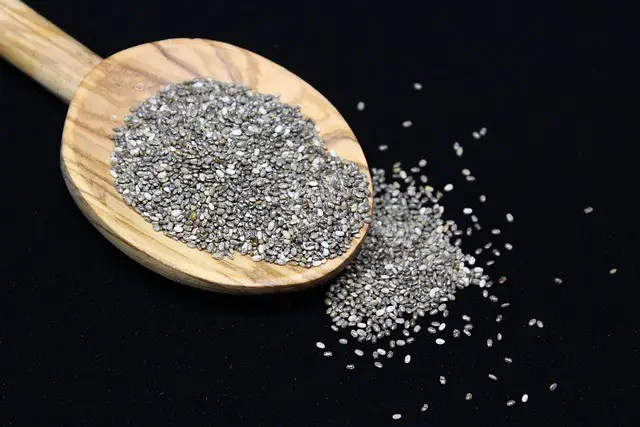
Another high-absorbent flour to add to your list is chia seed flour. Chia seeds, used to make this flour, have a high soluble fiber content. This flour is good for pudding because of how much water it sucks in to form a gel-like texture. You need a cup of chia seed flour to replace one cup of wheat flour.
How about the carb content of this seed flour? In one cup you will get:
- Energy: 298 kcals
- Total carbs: 56 g of carbs
- Dietary fiber: 56 g of fiber
- Net carbs: 0 g of net carbs
- Protein 26 g of protein
- Fat: 9 g of fat
Chia seed flour is 100% fiber. It’s used together with other flours when baking for better texture. Considering its fiber content, the flour can be good for diabetics to increase satiety and slow down digestion which will keep blood sugar in check.
Oat Fiber
There’s always a shock when it comes to low-carb eating! It is strange to see oats on the list, right? Well, let me clarify! Oats are high in carbs and not keto-friendly. Oat flour is also high in starch and is not allowed on keto. Oat fiber is different from oat flour in that the latter is made from ground oats while the former is made from ground oat husks.
One teaspoon serving of oat fiber has 3 g of total carbs, 3 g of fiber, and 0 g of net carbs. Combine oat fiber with almond flour for the perfect low carb pancakes.
Low Carb Flour for Roti
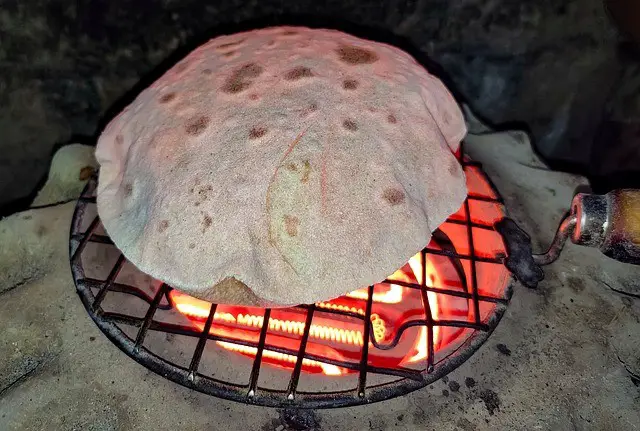
Roti is a crowd favorite in Indian cuisine. However, since they are high in carbs, they are off-limits for those following the keto lifestyle. You can use these low carb flour for baking substitutes to make your roti at home:
- Keto roti made with coconut flour.
- Keto roti is made with almond flour, whole psyllium husks, Himalayan salt, and olive oil.
- Cauliflower roti: add psyllium husks to grated flour to make low-carb rotis you will enjoy.
You can also make low carb roti using a blend of low carb flour for baking. Since gluten-free flour isn’t good for binding, add psyllium husks and ground chia seeds to bind your dough.
Low Carb Flour for Diabetics
The low carbs flour alternatives for baking listed above are all good for diabetics. They have a low glycemic index and glycemic load which means they will not have a significant impact on your blood sugar and insulin levels. But this doesn’t only apply to dry ingredients when baking. Make sure your ingredients are low carb, especially your sugar alternatives.
Is Cassava Flour Low in Carbs?
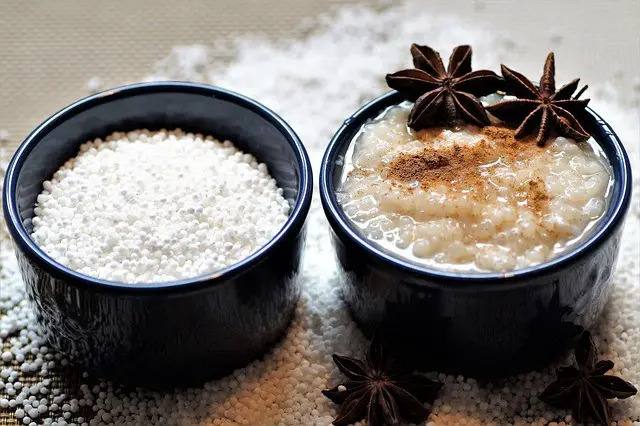
No, cassava flour is not low in carbs. According to the USDA, a 100 g serving of cassava flour contains 87.3 grams of total carbs, 4.8 grams of fiber, and 82.5 grams of net carbs. This is a high-starch flour and should be avoided.
Other flours to avoid are wheat flour, rice flour, chickpea flour, soya flour, and buckwheat flour. Grain flours are usually high in carbs.
Final Thoughts
You don’t have to give up on your passion for baking just because the main ingredient, flour, is high carb. There are low carb flour for baking alternatives you can use in place of regular flour. These options are not only low-carb but are also great sources of fats and proteins.
Something to keep in mind when using these flour is the ratios of low-carb flour to wheat flour you need to achieve similar end products. Also, use other low-carb ingredients so you stay within your carb allowance.
Which low-carb flour do you use the most in your kitchen since you started eating low-carb? How much of this flour do you use to replace a cup of wheat flour in your recipes? Let us know down below!

